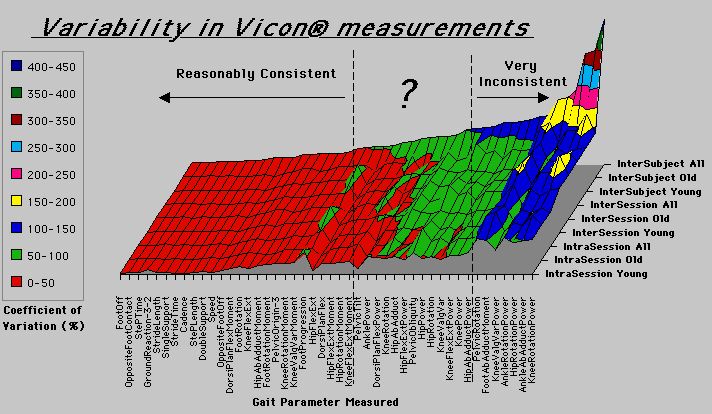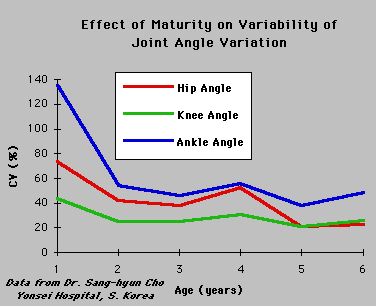 It is, of course,
impossible to separate these two sources of variation (true variation in
the subject's gait and artifact from the measurement procedure). We therefore
need some estimate of the variability to be expected. This is important
when, for example, comparing a patient's data against normative standards
- we need to know how much difference is significant.
It is, of course,
impossible to separate these two sources of variation (true variation in
the subject's gait and artifact from the measurement procedure). We therefore
need some estimate of the variability to be expected. This is important
when, for example, comparing a patient's data against normative standards
- we need to know how much difference is significant.
One frequently used estimate of variation is the standard deviation, which is often drawn on gait curves as dotted lines around the mean. One problem with this, though, is that the SD is slightly different at each point in the cycle. It would be nice to summarise this information, to calculate an "average SD" for the parameter over the whole gait cycle. This is what is called the coefficient of variation (CV), and it is simply the average standard deviation in the gait parameter divided by the average mean (Winter, 1991):
Notice that the sign of the mean (X) is ignored since many gait curves are biphasic and would otherwise have a mean around zero, making the CV go to infinity. This is probably not strictly correct mathematically, but it seems reasonable intuitively.

As can be seen in the above figure, some measures (especially the temporal-spatial parameters) show relatively little variation, whilst some (the transverse-plane joint powers) show almost no consistency. Note also that ankle measurements seem to be, in general, more consistent than hip variables, and the knee parameters are least consistent. We expected this, because of the particular problems in determining the knee-joint axis in the Davis marker set. We also expected that the inter-subject results would be more variable than those for individual subjects, and results recorded on different days to be more variable than those from the same session.


Note that children's gait become more consistent as it matures. But
note, also, that the pattern seen above is reversed, with ankle measurements
more variable than hip, which is more variable than knee. The results of
Dr. Selber & Wagner de Godoy (for 44 children aged 8-16 y), in
Brazil, confirm this trend (highest CVs at the ankle joint), as do published
results from David Winter for both 2D and 3D analysis
(although his 2D kinetic CVs seem to have been overestimated):
Sagittal-plane Coefficients of Variation (%)
|
|
|
|
|
|
|
|
|
|
|
|
|
|
|
|
|
|
|
|
|
|
|
Inter-subject |
|
|
|
|
|
|
|
|
|
|
Intra-subject |
|
|
|
|
|
|
|
|
|
|
|
|
|
|
|
|
|
|
|
|
|
|
|
|
|
|
|
|
|
|
|
|
|
|
|
|
|
|
|
|
|
|
| Dr.Selber' |
|
|
|
||||||
|
|
|
|
|
|
|
|
|
|
|
|
|
|
|
|
|
|
|
|
|
|
|
|
|
|
|
|
|
|
|
|
|
Winter, DA (1991) The biomechanics & motor control of human gait: normal, elderly & pathological (2nd. ed.), univ. of Waterloo Press, Waterloo, Ont.., p. 9.
Eng J, Winter D (1995). Kinetic analysis of the lower limb during walking:
What information can be gained from a
three-dimensional model? Journal of Biomechanics, 28:6, 753-758